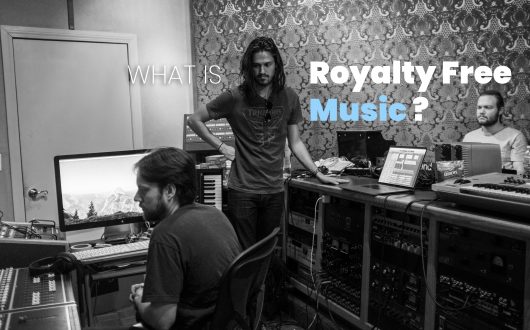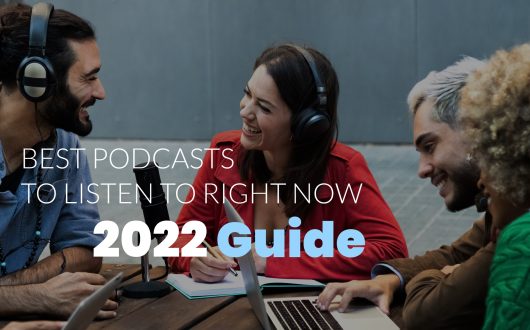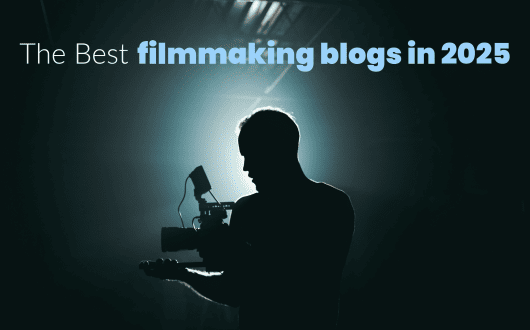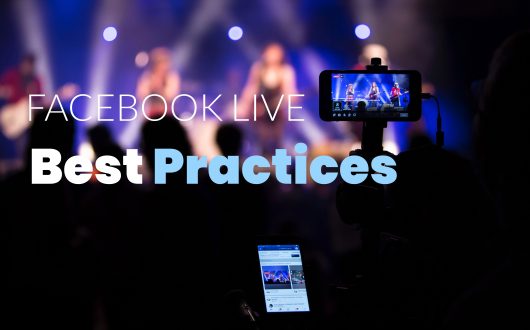
The Audio Buzz Blog
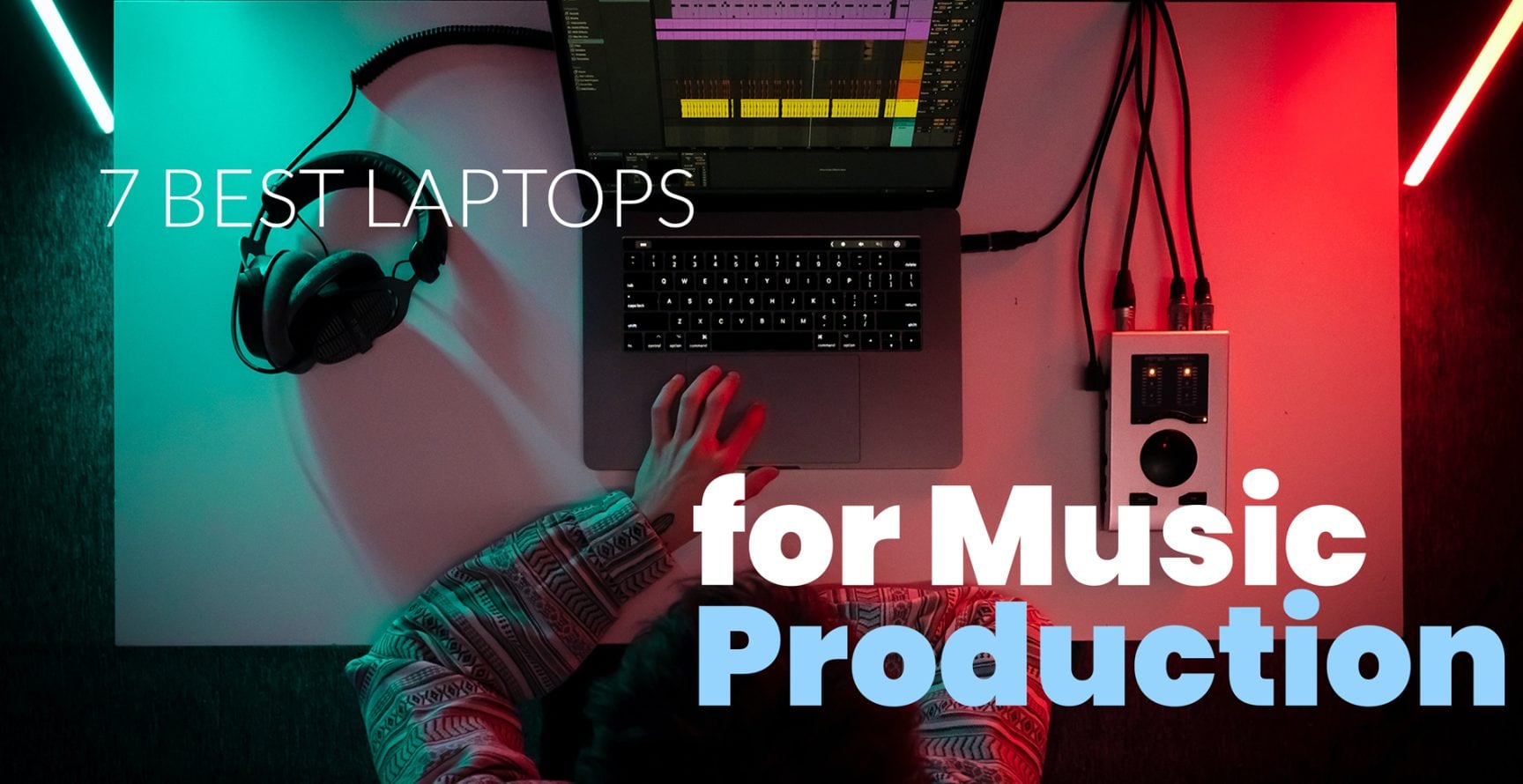
Best laptop for music production [2022 Edition]
Planning to advance your music career to the next stage? Then you might be interested in finding the best laptop for music production out there.
Luckily, you’re in the right place!
We’ll start by looking at what makes a good audio production laptop in the first place. After that, we’ll take you through a variety of options, depending on your goals and budget
To finalize our in-depth look, we’ll go through all the system and hardware requirements for popular music production software.
Let’s dive right in!
How to Choose the Best Laptop for Music Production
What should you consider when buying a new music production laptop? There’s more to it than excellent battery life and ample storage space.
Gaming laptops often make the cut because they’re designed for high-performance, and that’s just what you need. But you shouldn’t go and buy a gaming laptop straight away.
Let’s look at laptops’ components and see what they’re about.
CPU
One of the biggest topics of music production laptops is the CPUs. Why do they matter so much?
The CPU is your laptop’s brain. It handles all processes and commands. In terms of music production, the CPU takes care of synth channel stacking, plugin chains, etc. Running complex VSTs isn’t only hard on your RAM.
Calculating all variables and producing tone requires loads of processing power.
Some producers may run into a dilemma of choosing between strong single-threaded performance versus lower multithread power. Depending on how a DAW is optimized, it may be better to go with fewer cores but better clock speed. For example, FL Studio and Ableton Live can get very greedy with CPU requirements.
Be that as it may, you should never go lower than an 8-core CPU for serious music production. 6-core and 4-core CPUs can pull a lot of weight, too. But you should consider them only if your projects aren’t too demanding.
Graphics (GPU)
Do graphics even matter in music production?
Not really. Music production doesn’t require an intense graphics processing unit. Even integrated graphics cards work just fine for music production laptops.
While some DAWs and plugins have flashy designs or animations, most of them aren’t demanding. Nonetheless, you need graphics processing to render images on your screen. Though, that’s never a problem.
You can even save money when looking for a laptop for music production. In other words, don’t be swayed by a beefy graphics card alone. If you can find a laptop with excellent specifications but an integrated graphics card, there’s nothing wrong with going for it.
However, if you’re looking to create music videos for your tracks, you’ll need a graphics card that can do the heavy rendering.
RAM
RAM is most simply described as a computer’s short-term memory.
It’s a temporary data storage that handles all the active processes, tasks, apps, etc. Naturally, having more RAM means you can run more operations simultaneously.
When working with synths that use large audio libraries, your RAM needs space to handle all that information. Otherwise, you’re met with overheating, lagging, and crashing.
So, how much RAM does a music producer need?
An audio production laptop should have at least 8 GB of RAM. That’s the bare minimum if you intend on doing anything remotely serious. With that said, having at least 16 GB is probably a better choice for PCs.
Pay attention when getting your next laptop. Some models come with soldered RAM chips. When that’s the case, you can’t upgrade your RAM later.
Lastly, you want to work with either DDR4 or DDR5 ram, as DDR3 memory is outdated. These names simply refer to the memory speed, maximum capacity, etc.
Storage Space
Your projects will take up hundreds of gigabytes – or terabytes – down the line. Because of that, it’s common for producers to invest in external hard drives – preferably SSDs.
Traditional Hard Disk Drives (HDD) are cheaper than SSDs but much slower.
SSDs can read information ten times faster than HDDs and write data up to 20 times faster. In terms of practicality, your laptop will boot up much quicker and have shorter loading times with DAWs.
You may be tempted to get a cheaper hard drive than a pricey GB SSD. But remember – cheap storage comes at the cost of speed.
For every serious music producer, hefty external drives are a must, either way. So you may as well opt for a built-in SSD for convenience, then use external drives to store sample libraries, VSTs, etc.
Battery Life
Whether battery life is crucial for you depends on how you work. Of course, long battery life is excellent. But when you’re at a gig, you’ll probably keep your laptop plugged in the whole time. So in some cases, battery life doesn’t matter as much.
Of course, some DJs can pay attention and periodically charge their laptops during shows.
If you see a laptop with decent specifications (CPU, RAM, storage space, etc.) but poor battery life, it’s not a deal-breaker.
Tip: It’s a general rule to keep your battery between 30% and 80% to prolong battery life, especially with today’s lithium-ion batteries.
Ports
Music producers often have some external equipment connected to their laptops in most cases. A typical setup would include an external sound card, a MIDI keyboard, an additional hard drive, or an extra monitor.
A good laptop for music production will have multiple ports to connect such equipment. Nearly every computer has at least two or three. However, the type of featured ports is what matters the most.
For example, a single Thunderbolt 3 or 4 can replace two or three lower-spec ports. Once paired with a docking station, Thunderbolt ports greatly expand the scope of extra equipment you can connect without losing speed.
USB 4 connectors achieve a similar speed as Thunderbolt (40Gbps), though they lose half of it at one-meter cables or above.
These ports are also vital for external monitors with high resolutions (more resolution = more space to work with) – 4K image on a 27-inch screen requires Thunderbolt 4, for example.
Apple’s Best Laptop for Music Production
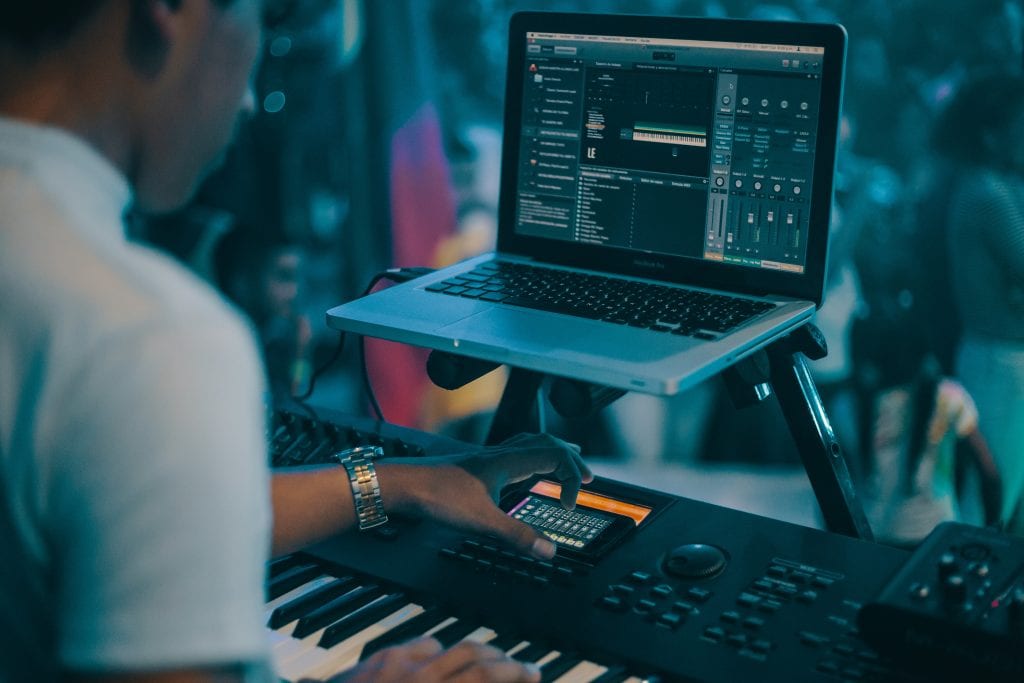
Deciding on your dream laptop is one thing. But what if you already have your heart set on a particular DAW?
Fact is – Apple laptops offer fantastic performance and a variety of software you can use. But such performance and variety come at a cost.
Literally.
It’s no secret that Apple has some of the most overpriced equipment available. And whether you get value for your money depends on the user.
Now, Apple’s Logic Pro is a favorite among many producers. But it’s only available on the macOS; Windows and Linux systems can’t run it.
You may already be used to the macOS – or Logic Pro specifically. Perhaps you’d like to continue using it. After all, sticking with a DAW you’re already familiar with has many advantages.
If a macOS laptop is something you simply can’t part with, then here are the best laptops for you to consider:
1) Apple MacBook Pro 16″ M1 Max
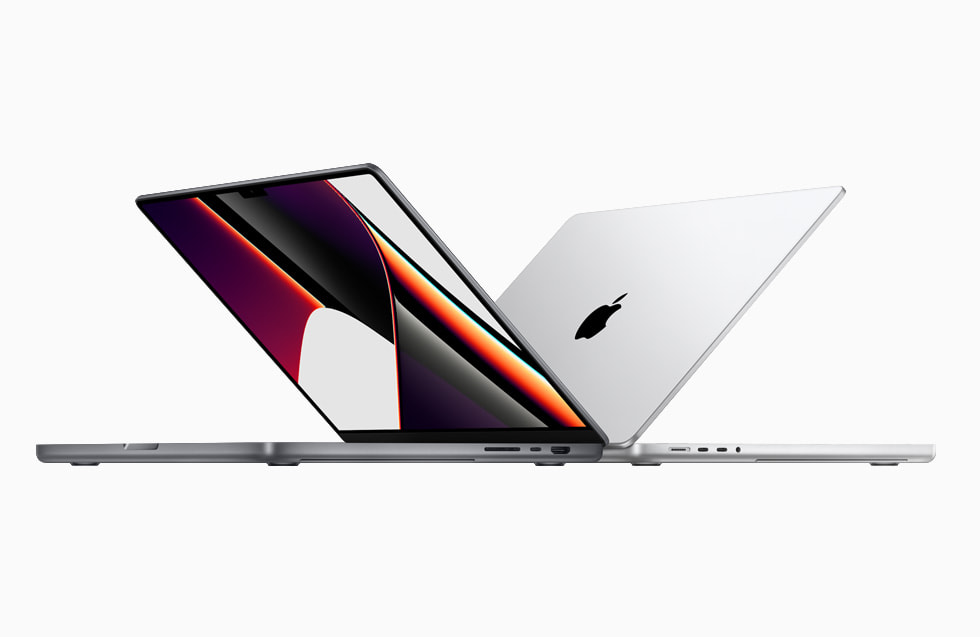
The MacBook Pro M1 Max is an absolute beast, earning its place as one of the greatest music production laptops available.
Specifications
- Screen Size: 16″
- CPU: Apple M1 Pro 10 Core, 3,2 GHz
- Graphics: Apple M1 GPU, integrated
- RAM: 32 or 64 GB, unified
- Storage: Up to 8 TB SSD
- Battery life: 100 Wh
- Ports: 3 x Thunderbolt 4, SD card reader, HDMI, audio jack
Apple’s latest generation of CPUs – the M1 – is one of the fastest in the world. With each new iteration (i.e., the M1 Pro and M1 Max chips), we’re witnessing more impressive results.
At launch, the M1 chips haven’t managed to reach their full potential due to many apps not being optimized for them. Except for Logic Pro.
Since then, many developers have upgraded their software to be compatible with this new generation of CPUs, bringing drastic improvements.
Incompatibility is still an occasional issue. But Apple’s Rosetta emulator remedies this effectively.
The remaining downside we have to mention is RAM. It’s non-upgradeable, which initially sounds risky and may draw a few producers away.
But remember – you get a minimum of 32 GB with the M1 Max. And the way Apple’s M1 CPUs are structured, 32 is more than enough for heavy-hitting projects.
All of that aside, the components work astonishingly well together. And coupled with three lightning-fast Thunderbolt 4 ports, you can massively expand your workstation.
Finally – the sound quality is fantastic. MacBook speakers are famous for their clear quality and loudness. That’s wonderful, but you won’t be working with built-in speakers – you need quality headphones.
M1 Macs’ headphone jacks are ahead of the competition in lossless audio quality. Lossless playback is nearly indistinguishable with and without a DAC. So if you’re on the go, all you need is your laptop and a pair of headphones to get extra-high definition audio.
Yes, it’s a hefty investment. But if you’re serious about production, you want a robust, reliable piece of equipment that can run everything you throw in its way – and this is it.
2) Apple MacBook Air M1
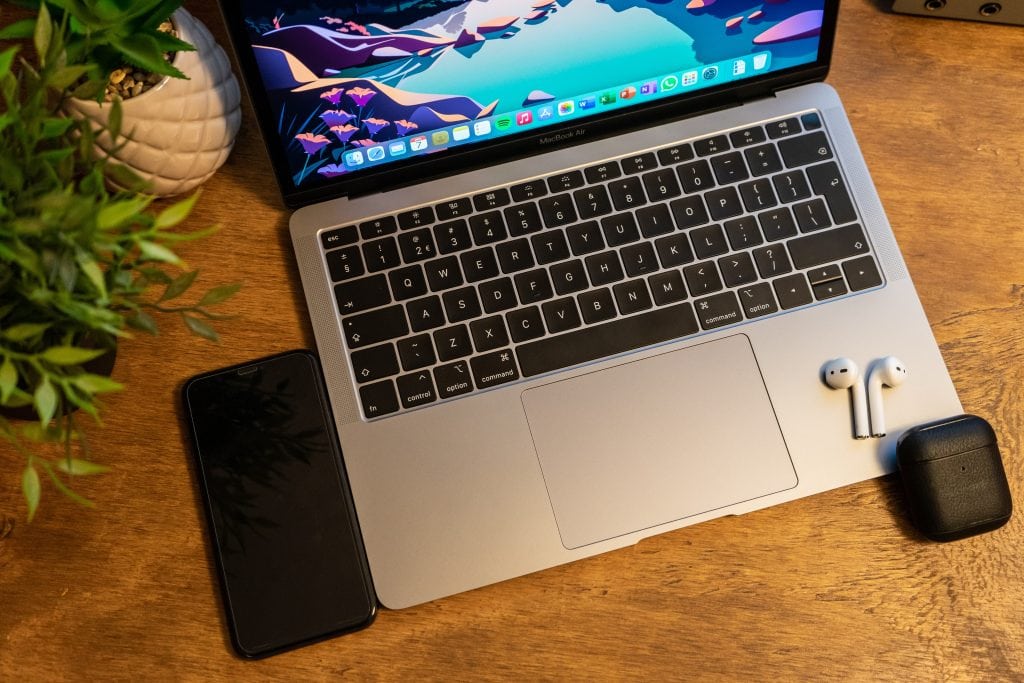
Consider this entry as Apple’s “budget” laptop for music production. This budget option will still set you back $1000. However, that’s still around $2000 less than the M1 Pro, not even mentioning the M1 Max.
As with the M1 Pro, the M1 Air enjoys all the benefits of this new generation of CPUs. In the same way, we’re still waiting for all the software updates to drop and optimize many issues.
This MacBook Air can hold its own through a large workload, considering its lower specs than the M1 Pro and M1 Max. However, it comes with a single audio jack and two Thunderbolt 4 ports.
Specifications
- Screen Size: 13.3″
- CPU: Apple M1 8 Core, 2.1 GHz
- Graphics: Apple M1 GPU, integrated
- RAM: 8 GB (up to 16 GB), unified
- Storage: 256 GB (configurable up to 2 TB)
- Battery life: 49.9 Wh
- Ports: 2 x Thunderbolt 3/USB 4, audio jack
One major aspect of the MacBook Air is its fanless design. This laptop has no coolers whatsoever. Instead, it relies on passive cooling, as seen with iPads.
It’s a brave move, but Apple delivered. This laptop handles cooling well and outperforms many Windows laptops with similar or better specs.
The Air M1 shares the M1 Max’s downside – the non-upgradeable RAM. But likewise, it shares one of its greatest assets – the pristine sound quality. All M1 laptops share that trait, which is why they’re so expensive.
The small number of ports shouldn’t sway producers away. Both are Thunderbolt 3s, meaning that you get much more than meets the eye. For example – extra storage, a MIDI keyboard, and two additional monitors to compensate for the 13.3″ display. All you need is a docking station.
Though not one of Apple’s most powerful products, this is still one of the best laptops for music production in its price range.
Best Windows Laptops For Music Production
Now that we’ve gone over the best Apple laptops for music production let’s move on to more flexible laptops. Your best laptop will depend on your budget, skill level, and other specific needs, as with our previous examples.
1) Asus Zephyrus Duo 15 SE (GX551)
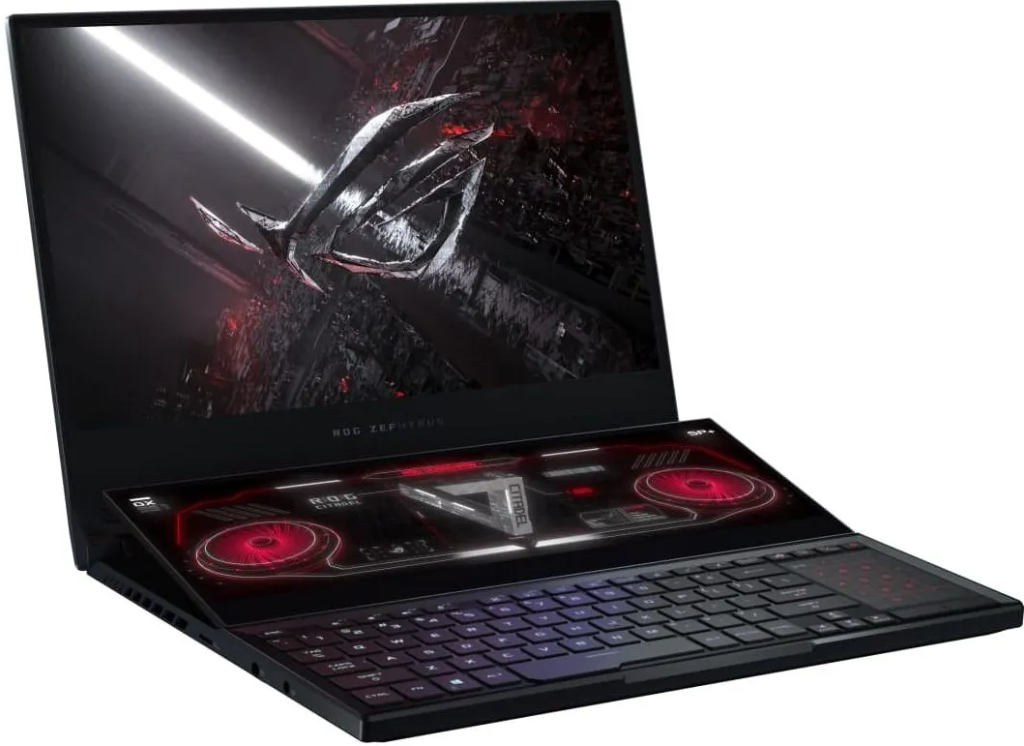
We have a creator’s dream for the first entry on our non-Apple laptop list. Full disclaimer: this laptop isn’t just for music production. It’s made with all kinds of content creation and gaming in mind.
The Zephyrus Duo 15 SE is up there with Apple’s most expensive products in terms of pricing. For a Windows laptop, that’s very ambitious. Is this laptop worth it?
You decide.
Specifications
- Screen Size: 15.6″ + 14.1″
- CPU: AMD Ryzen 9 5900HX, 8 cores, 3.3 GHz
- Graphics: NVIDIA GeForce RTX 3060
- RAM: Up to 32 GB
- Storage: SSD, Up to 2 TB
- Battery life: 90 Wh
- Ports: 1 x USB-A gen 3.2, Thunderbolt 3 (Type C), HDMI, MicroSD card reader, audio jack
One of Zephyrus Duo’s main features is instantly noticeable – the added touchscreen. Apart from the 15.6″ display, the laptop also features a 14.1″ touchscreen that folds out.
In most cases, this kind of design is just a gimmick. But Zephyrus Duo’s second screen serves a purpose. Many applications run natively on both screens and feature contextual panels for easier workflow.
For example, when you load up Cubase, you’ll see the mixer panel on the touchscreen right away. No need to tinker with any settings. Everything runs natively, giving you more real estate to work with on the main display. That also goes for apps like Premiere, Photoshop, etc.
Asus’ Zephyrus Duo features Dolby’s 5.1.2-channel surround sound technology. It has two tweeters and two Smart Amp woofers that bounce sound off your work table. You can optimize sound settings manually or choose one of the available six presets. It also features two-way noise cancellation for advanced background noise removal.
The laptop supports DDR4 RAM, up to 32 GB, providing excellent speed and performance even during some demanding projects.
One major downside of it, however, is the lack of ports. Considering this laptop’s content creation concept, it doesn’t feature nearly enough ports for highly professional production.
2) Razer Blade 15 Studio Edition
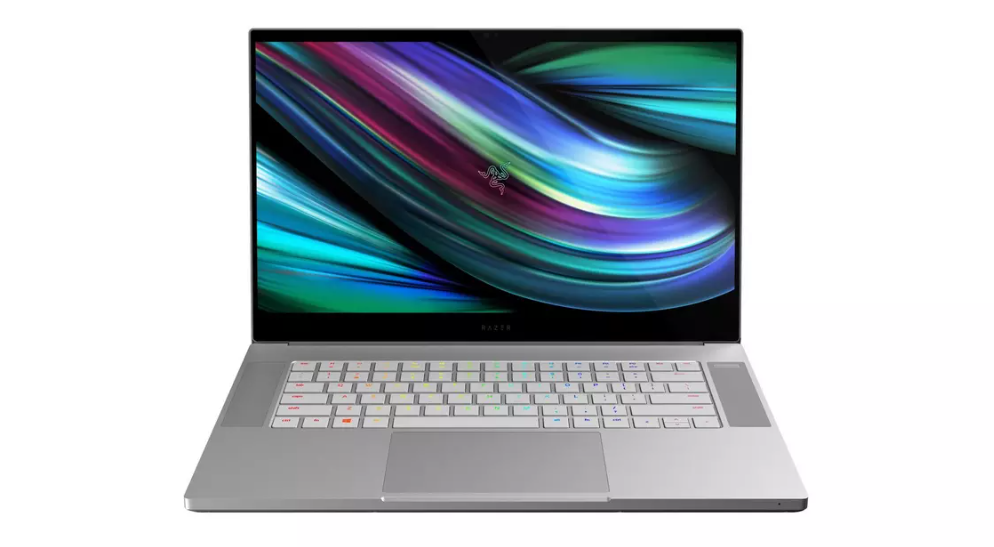
The name tells you what you need to know. It’s not just a music production laptop but a jack of all trades for media creation.
The Razer Blade 15 is a sleek, powerful laptop designed not only for producing music but multimedia creation in general.
Specifications
- Screen Size: 15.6″
- CPU: Intel Core i7-10875H, 8 cores, 2.3 GHz
- Graphics: NVIDIA Quadro RTX 5000 Max-Q
- RAM: Up to 64 GB
- Storage: Up to 2 TB SSD
- Battery life: 80 Wh
- Ports: 3 x USB-A 3.2 Gen 2, Thunderbolt 3 (USB-C), HDMI, Mini DisplayPort, audio jack
Razer’s Blade 15 supports up to 64 GB of RAM (DDR4) and up to 2 TB of SSD storage. Even if you frequently edit videos, you don’t need an external hard drive to work.
You also have various options for external equipment. With four total USB ports and an HDMI port for monitors, you can connect any piece of equipment you need for producing music.
The ports themselves provide a lot of breathing room. You get three USB gen 3.2’s and a Thunderbolt 3 to work with. You can, of course, expand the Thunderbolt even further.
On the other hand, the battery life isn’t that great. You can expect it to last up to two hours with even remotely intensive work. Hence, it’s not ideal for producers on the go.
One enticing thing about Razers laptops is that you get an FL Studio (Producer Edition) license for a year with every purchase. So not only do you get a new laptop, but also a $200 audio interface as a bonus.
Finally, in terms of speakers – gaming laptops aren’t known for exceptional built-in speaker quality, and the Razer 15 strikes the middle ground. They’re decent, but nothing noteworthy.
3) Razer Blade 17
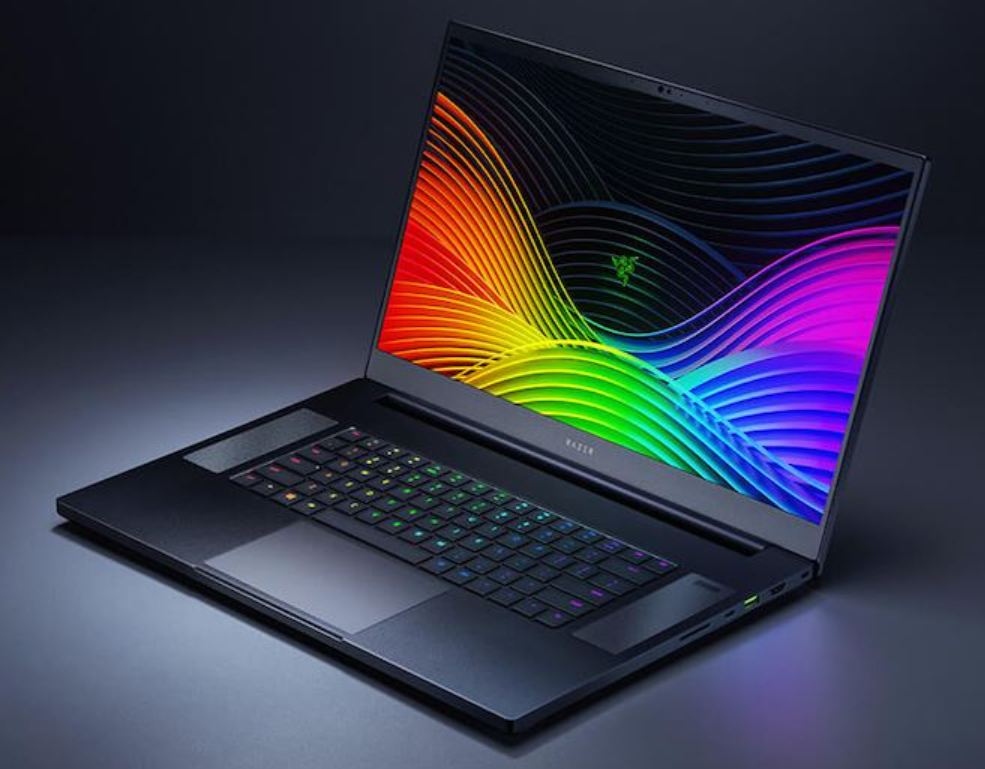
The Razer Blade 17 is one of your best options if you don’t want an M1 Max but don’t want to cash out on the Zephyrus Duo. It’s in the same price range as the M1 Max, but does it offer the same performance?
Specifications
- Screen Size: 17.3″
- CPU: Intel Core i7-12800H, 14 cores, 2.4 GHz
- Graphics: Intel UHD Graphics
- RAM: Up to 64 GB
- Storage: Up to 2 TB SSD
- Battery life: 70.5 Wh
- Ports: Thunderbolt 3, 3 x USB-A 3.2 gen 2, HDMI, SD Card reader, audio jack
In short, the Blade 17 and the Pro M1 are almost tied. Intel’s i7-12800H offers marginally higher total CPU power than the M1 chip. Of course, Apple might get the edge due to its hardware cohesion.
On the other hand, you can upgrade the Razer Blade 17 and outperform the Pro M1 with fewer expenses. Especially RAM and SSD storage space. And yes, this laptop does come with DDR5 memory – a solid contender to Apple’s unified memory, unlike DDR4.
The Blade 17 has three USB-A 3.2 Gen 2 ports and two Thunderbolt 4 USB-C 3.2 Gen 2 ports. Such a setup offers incredible versatility in the additional equipment you can connect.
The speakers are mid-tier, begging the need for high-quality headphones and external audio.
Lastly, since this is a Razer laptop, you also get the one-year FL Studio license to kickstart your projects!
4) MSI Katana GF66
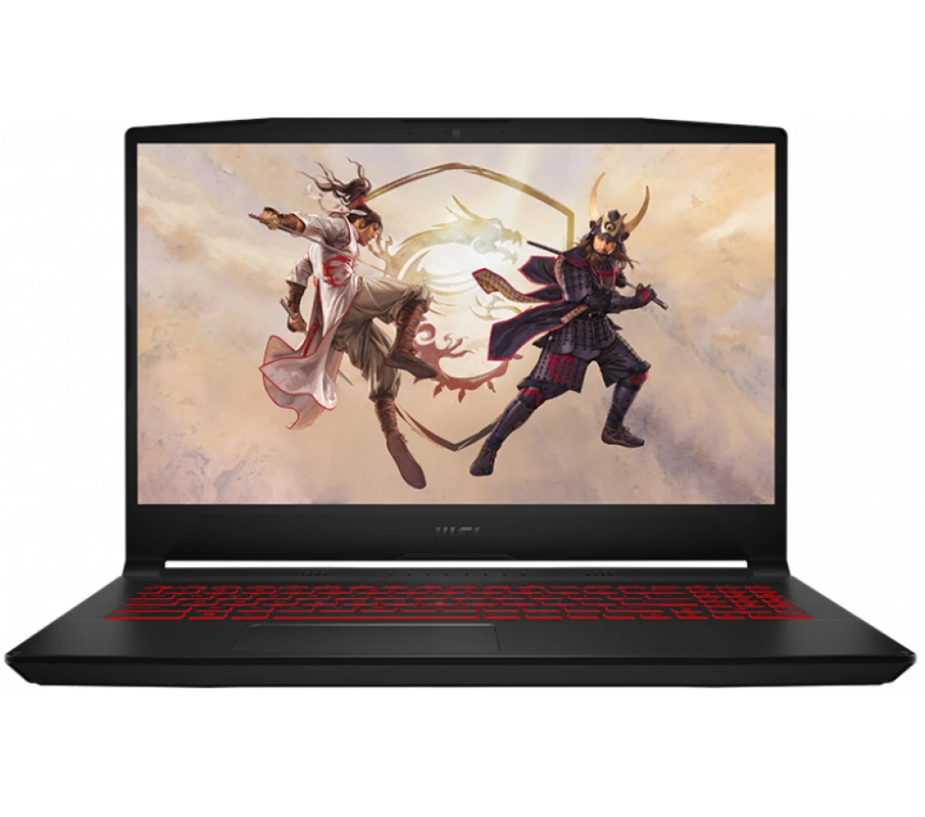
Here we have one of the most budget-friendly gaming laptops currently. Priced at around $800, MSI’s Katana GF66 provides exceptional value given the work potential.
Specifications
- Screen Size: 15.6″
- CPU: Intel Core i7-11800H, 8 cores, 2.3GHz
- Graphics: NVIDIA RTX 3060
- RAM: Up to 64 GB
- Storage: Up to 1 TB SSD
- Battery life: 53 Wh
- Ports: USB-C 3.2 Gen 1, 2x USB-A 3.2 Gen 1, USB-A 2.0, RJ-45, HDMI, audio jack
The Katana GF66 comes with a 15,6″ display, striking the middle ground in size.
It can hold up to 64 GB of RAM (DDR4), giving you the option to work with vast amounts of tracks simultaneously.
To back it up, you also get Intel’s i7 CPUs. The 11th generation i7 listed here provides a good balance of single and multithreaded processing. But it doesn’t excel at any of them, sadly.
Even if you work with a resource-intensive DAW, you’ll be good to go as long as you have at least 16 GB of RAM. This laptop will handle any platform you throw at it.
You can hook up to 1 TB of SSD storage on this machine, erasing the need for external drives. With a terabyte, you can have a full sound library without worrying about storage.
The Katana GF66 has four USB ports mounted on both sides, apart from the HDMI and ethernet connection. More Specifically, you get three type-As and a type-C. Only one type-A is older than 3.2.
MSI promotes this model as having crystal clear hi-res audio, but it’s not as advertised. The speakers work great for mid and high frequencies, but there’s a noticeable lack of bass. You can use the included Nahimic audio app to boost audio quality, but you’ll still need external equipment for real projects.
5) Alienware X17 R1
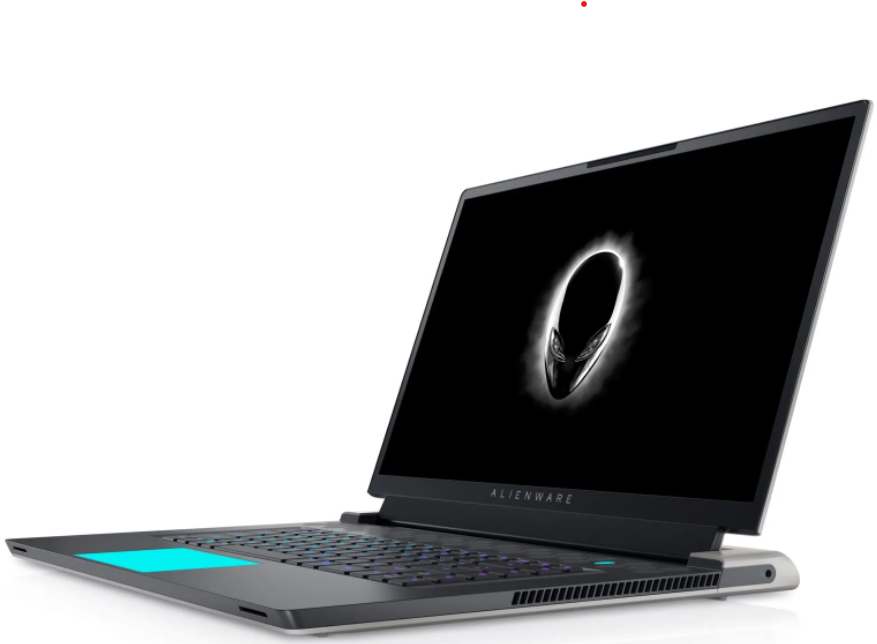
As you know, Alienware is oriented towards the gaming crowd. Their computers and peripherals are all about that sweet RGB lighting. Another thing you can expect from Alienware is a futuristic, robust, and edgy design.
But since we’re dealing with a gaming laptop, you can expect the X17 to pack a punch.
Specifications
- Screen Size: 17.3″
- CPU: Intel Core i7-11800H, 8 cores, 2.3 GHz
- Graphics: NVIDIA GeForce RTX 3060
- RAM: Up to 64 GB
- Storage: 256 GB SSD
- Battery life: 87 Wh
- Ports: 2 x USB 3.2 gen 1, USB 3.2 gen 2, Thunderbolt 4, RJ-45, HDMI, audio jack, microSD reader
One of the best things about the X17 R1 is the 17.3″ display. That’s an excellent size for a music production laptop. You’ll have a nice overview of your projects without having to squint.
The X17 R1 comes with Intel’s i7-11800H, which gives a solid, balanced performance, as we’ve mentioned earlier.
Coupled with the 64 GB RAM capacity (DD4), you can dig into projects with dozens of tracks stacked on top of each other. But even 16 and 32 GB RAM will do just fine for most cases.
This laptop has four speakers: two tweeters and two woofers, and all of these come with internal amplifiers for louder sound.
The major downside is the storage. With the X17 R1, you get only 256 GB of SSD storage, which isn’t nearly enough long-term. However, it does have two SSD slots, but due to the 256 GB limit, you’re better off using one of the USB slots for external storage.
Luckily, this laptop does come with three USB ports, one of which is Thunderbolt 4. And considering that you don’t need a second monitor due to the large display, there’s plenty of room for experimentation.
6) Microsoft Surface Pro 8
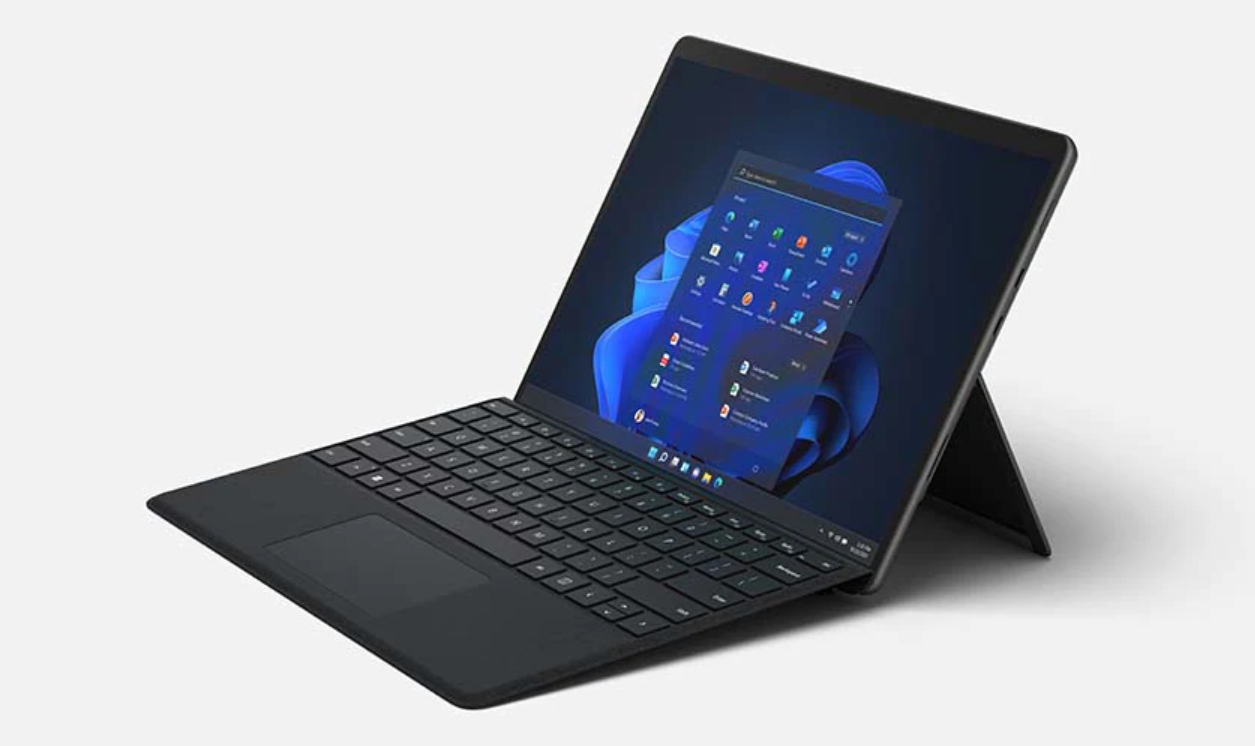
The Surface Pro 8 is a weird one. It’s not exactly a laptop, nor a tablet.
It’s somewhere in between. Think of it as a tablet that you can turn into a PC with a few clicks. You may be thinking: what is a tablet doing in the middle of a laptop list?
Surprisingly, this “tablet” has become a daily driver for many producers. One of its main selling points is its flexibility.
Specifications
- Screen Size: 13″
- CPU: Intel Core i5-1135G7, 4 cores, 2.4 GHz
- Graphics: Intel Iris Xe Graphics
- RAM: 16 GB
- Storage: Up to 1 TB SSD
- Battery life: 50.2 Wh
- Ports: 2 x USB-C with USB 4.0/Thunderbolt 4, audio jack, Surface Connect port
The screen is small, providing only 13″ of room. The Surface Pro 8 is a 2-in-1 device, and you can only expect so much. Even if you prefer working with a touch screen, the screen can be clunky, and sweaty hands make things even more difficult.
As for the CPU, Intel’s i5-1135G7 is a decent choice if you’re looking to save money. But you will run into some latency issues and overexertion if you stack a few dozen tracks to render in real-time, especially with CPU-intensive DAWs like Ableton.
Invest in as much RAM as you can to mitigate the quad-core CPU. The 11th generation i5 can do a lot, but having around 4 GB of RAM will slow everything down considerably.
To boost performance further, don’t cut down on storage. The Surface Pro 8 can hold up to 1 TB SSD – you’ll want to use it. And to boost productivity, utilize the two Thunderbolt 4 ports for external equipment and use the laptop as a dock. Thunderbolt 4 opens quite a few options.
The battery holds rather well. Nothing too exceptional, but you can get a few work hours without charging.
And finally, the speakers. Placed behind the top bezel, Surface Pro 8’s speakers have surprising quality for a portable device. 2-in-1 laptops aren’t known for their pristine sound quality, so it’s nice to see something decent.
7) HP Envy X360
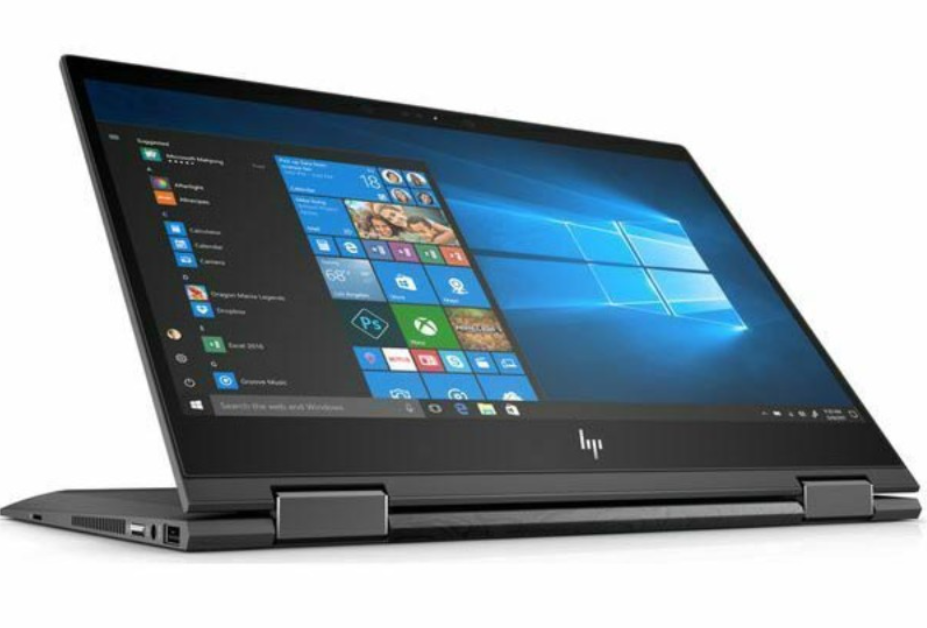
HP’s Envy X360 is a fantastic laptop for creators on the go. As the “360” moniker implies, you can flip the display around and use it as a tablet via touch.
For a sub $1000 mark, you can find laptops with better components. The Envy is recommended to young producers looking for something light and convenient.
Specifications
- Screen Size: 13.3″
- CPU: AMD Ryzen 7 4700U, 8 cores, 2.0 GHz
- Graphics: AMD Radeon Shared Graphics
- RAM: Up to 32 GB
- Storage: Up to 512 GB SSD
- Battery life: 51 Wh
- Ports: 2 x USB-A, USB-C, HDMI, audio jack, SD Card reader
The HP Envy X360 comes with a 13.3″ screen. It can be uncomfortable to work with, especially for those with poor eyesight.
Ryzen’s eight-core CPU offers decent performance considering Envy’s price. Pair it with at least 16 GB RAM, and you’ll be biting through some demanding projects.
Envy’s ports don’t offer anything special, but they’re reasonable. It features two USB type-As and a type-C, all of which are 3.0. This supports the bare minimum of externals you need. (i.e., additional storage, a soundcard, and a monitor).
The laptop lacks storage, but considering it’s meant for newer producers, it shouldn’t pose a problem initially. Though you’ll find it quickly fills up.
At best, the speakers are average, greatly lacking bass; external speakers are a must-have.
And lastly, the battery on the Envy X360 holds rather well. Expect it to last between 3-6 hours for simple projects, which is still excellent considering this laptop can cost around $650.
Music Production Software Requirements
To help you decide on your ideal laptop, here’s a list of popular DAWs’ requirements.
We’ll go through the requirements of each app. That way, you can decide whether or not a laptop will fit your needs based on the music production software you intend to use.
We’ll focus on the latest versions of the listed software. However, keep two things in mind:
- You can always work with earlier software versions with lower requirements.
- These are only suggested minimum requirements. You can work with weaker hardware and achieve great results with the right approach.
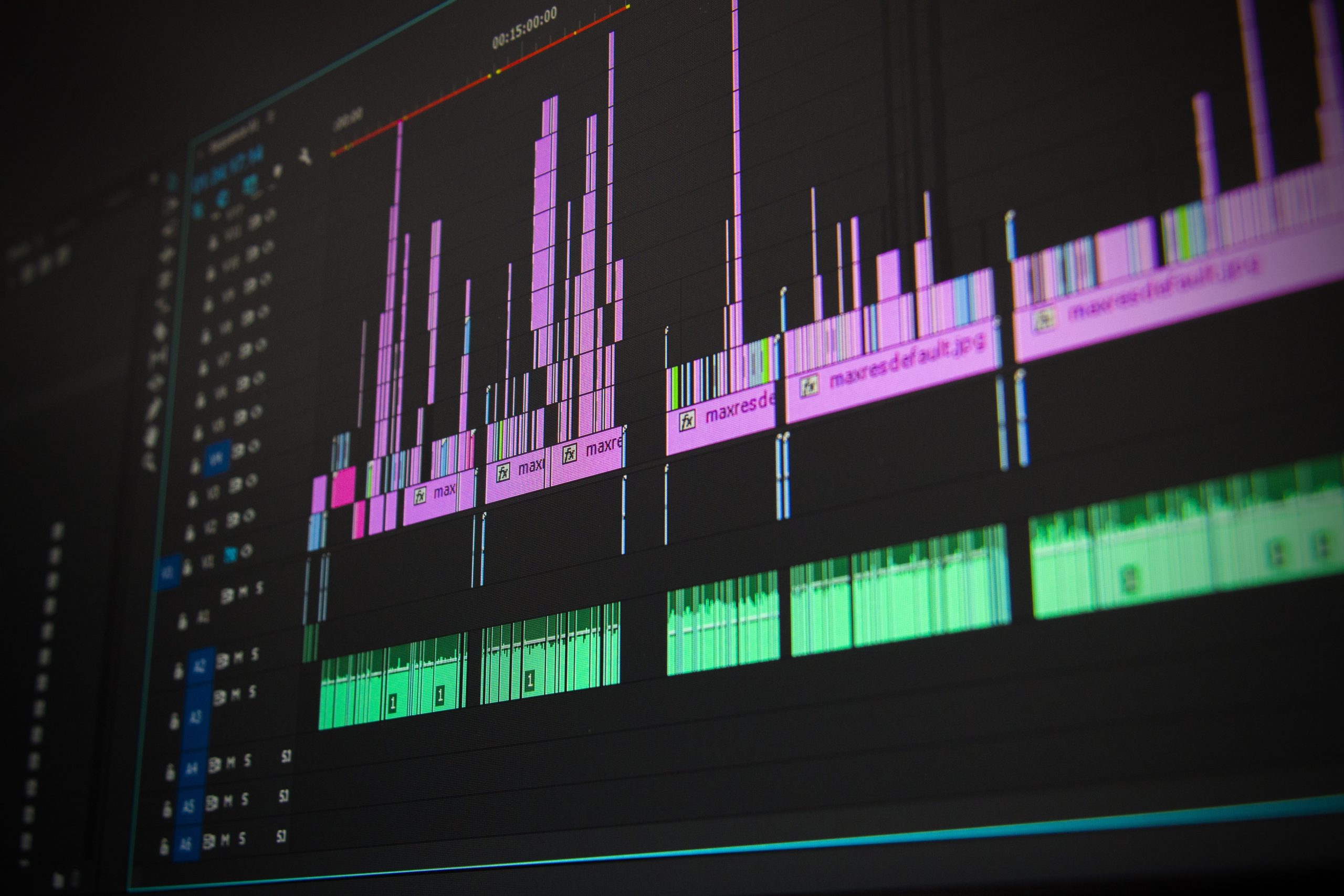
Cubase Pro 12
- Operating system: 64-bit Windows 10 or 11, macOS Big Sur or Monterey
- CPU Minimum: Intel Core i5 or equivalent
- Minimum RAM: 8 GB
- Storage required: 70 GB
FL Studio
- Operating system: Windows 7 or higher, macOS High Sierra or higher
- CPU minimum: No specific requirements. The performance will scale along with your CPU
- Minimum RAM: 4 GB
- Storage required: 4 GB
Logic Pro (Mac Only)
- Operating system: macOS 11.5 or higher
- Intel CPUs: Intel Core i5, quad-core chip, or higher
- Apple CPUs: Silicon M1, M1 Pro, or M1 Max
- Minimum RAM: 6 GB
- Storage required: 72 GB
Pro Tools
- Operating system: 64-bit Windows 10, macOS 10.14.6 or higher
- CPU Minimum: Intel Core i5, Apple M1
- Minimum RAM: 16 GB
- Storage required: 15 GB
Ableton Live
- Operating system: Windows 10 or higher, macOS El Capitan or higher
- CPU Minimum: Intel Core i5 or equivalent multi-core CPU
- Minimum RAM: 8 GB
- Storage required: 6 GB
The Wrap-Up
That sums up our best laptops for music production!
The MacBook Pro M1 and the Macbook Air take the top spots as far as Apple laptops go. The Apple MacBook Pro M1 is incredible.
It costs a small fortune, but pros consider it worth the money. And, of course, the MacBook Air takes the win for Apple’s budget laptops for music production.
On the flip side, the Zephyrus Duo takes the spot as the best Windows laptop.
There are high-end laptops with incredible amounts of RAM, the latest CPUs, and amazing battery life. But even a cheaper model can be a great laptop in the right hands.




